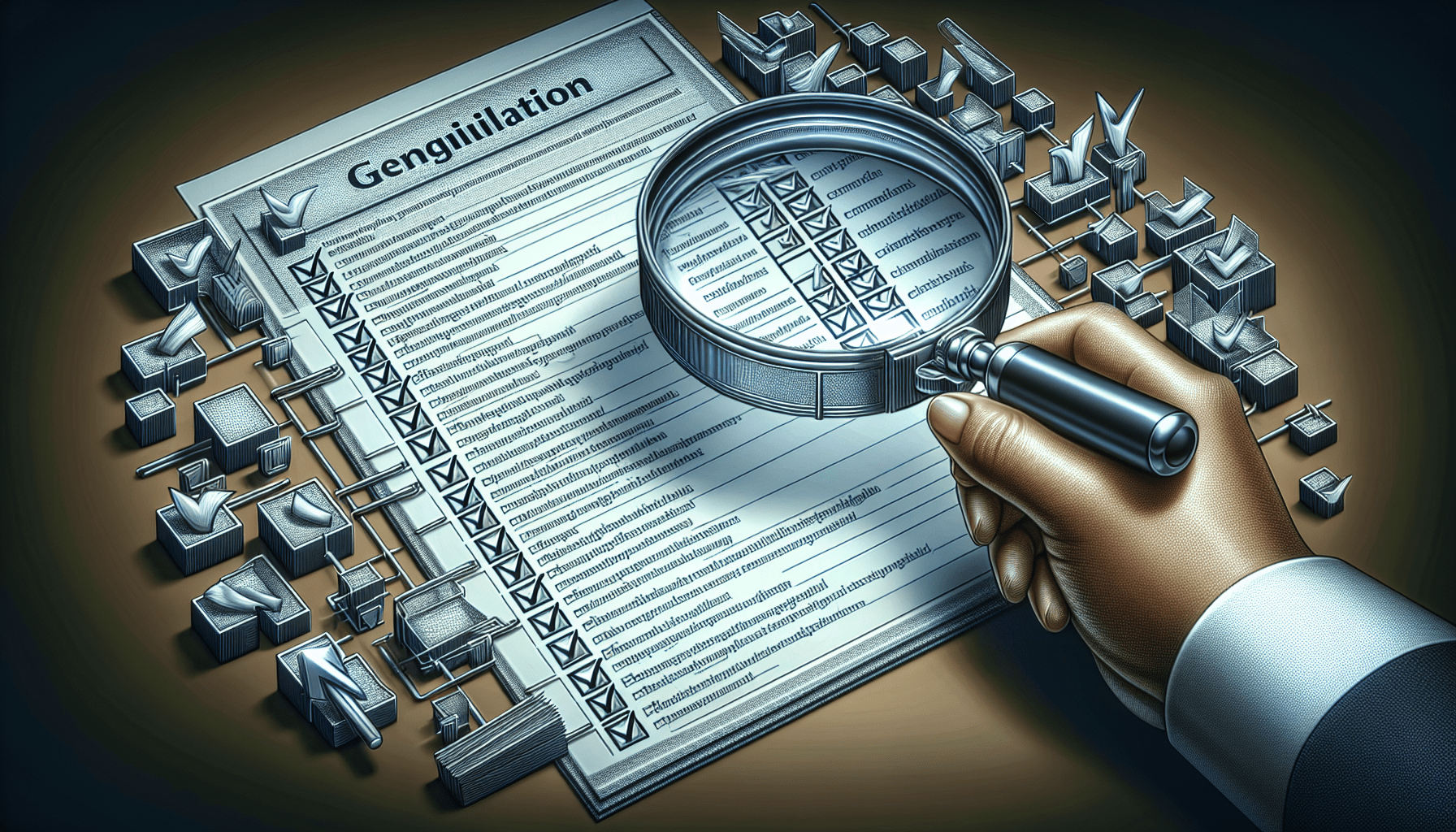Ensuring regulatory compliance is essential for any business to operate within legal boundaries and maintain trust with stakeholders. One effective method to accomplish this is through regular audits. By conducting thorough audits, organizations can identify any gaps or violations in their practices, policies, and procedures, ensuring prompt corrections and consequent adherence to regulations. This article explores the importance of audits in achieving regulatory compliance, highlighting their role in mitigating risks, enhancing transparency, and fostering a culture of integrity within an organization.
1. Introduction
In today’s complex and highly regulated business environment, ensuring regulatory compliance is crucial for organizations across all industries. Non-compliance can lead to severe legal consequences, damage to reputation, and risk to consumer interests. Therefore, conducting regulatory compliance audits is an essential practice for organizations to effectively manage and mitigate these risks. This article will explore the importance of regulatory compliance, the key elements of compliance audits, the process of conducting audits, the benefits of audits, the challenges associated with compliance, and the technologies and best practices for ensuring regulatory compliance.
2. Importance of Regulatory Compliance
2.1 Avoiding Legal Consequences
Regulatory compliance is important as it helps organizations avoid legal consequences. Failure to comply with applicable laws and regulations can result in hefty fines, penalties, and even legal actions. Regulatory bodies such as government agencies and industry-specific authorities have the power to investigate and take legal actions against non-compliant organizations. By conducting regular compliance audits, organizations can identify and rectify any compliance gaps, helping them to stay on the right side of the law and avoid legal consequences.
2.2 Building Trust and Reputation
Maintaining a good reputation is essential for any organization’s success. Compliance with regulations builds trust among stakeholders, including customers, investors, and partners. Demonstrating a commitment to compliance through regular audits signals that the organization values ethical conduct and is dedicated to upholding industry standards. This can enhance the organization’s reputation and credibility, leading to increased customer loyalty, improved business relationships, and a competitive edge in the market.
2.3 Safeguarding Consumer Interests
Regulatory compliance is crucial for safeguarding the interests of consumers. Compliance with regulations ensures that organizations operate in a manner that protects consumers from potential harm, fraud, or deception. Compliance audits help identify any areas where consumer interests may be at risk and allow organizations to take corrective actions to prevent any harm or unfair practices. By prioritizing regulatory compliance, organizations can demonstrate their commitment to consumer protection and ethical business practices.

3. Understanding Audits
3.1 Definition
An audit is a systematic examination and evaluation of processes, systems, and controls within an organization to ensure compliance with applicable laws, regulations, and industry standards. The primary objective of an audit is to assess the effectiveness of an organization’s internal controls, risk management practices, and compliance with regulatory requirements.
3.2 Types of Audits
There are various types of audits, including financial audits, operational audits, and compliance audits. Financial audits focus on examining an organization’s financial statements and ensuring accuracy and compliance with accounting standards. Operational audits assess the efficiency and effectiveness of an organization’s operations. Compliance audits specifically target the organization’s compliance with laws, regulations, and industry standards.
3.3 Objectives of Audits
The main objectives of regulatory compliance audits are to:
- Identify compliance gaps and areas of non-compliance
- Evaluate the effectiveness of internal controls and processes
- Assess the organization’s adherence to applicable laws, regulations, and industry standards
- Recommend corrective actions to mitigate non-compliance risks
- Provide assurance to stakeholders regarding the organization’s compliance efforts
4. Key Elements of Regulatory Compliance Audits
4.1 Compliance Standards and Regulations
The first key element of regulatory compliance audits is a thorough understanding of the relevant compliance standards and regulations. Compliance requirements can vary based on industry, geography, and the specific nature of the organization’s operations. Auditors need to be well-versed in applicable laws and regulations and stay updated with any changes or revisions to ensure accurate assessment of compliance.
4.2 Internal Controls and Processes
Internal controls and processes play a critical role in achieving and maintaining regulatory compliance. Auditors assess the effectiveness of internal controls in preventing and detecting non-compliance. This includes reviewing the organization’s policies, procedures, and documentation to ensure they align with regulatory requirements. Evaluating the establishment and implementation of controls helps identify any weaknesses or areas for improvement.
4.3 Documentation and Recordkeeping
Accurate and comprehensive documentation and recordkeeping are essential for regulatory compliance audits. Auditors review the organization’s documentation practices to ensure that proper records are maintained and retained as required by regulations. This includes policies, procedures, contracts, financial records, and other relevant documents. Adequate recordkeeping supports the organization’s ability to demonstrate compliance and provides a trail of evidence in the event of an audit or investigation.
4.4 Training and Education
Training and education are crucial for maintaining a compliance-oriented culture within an organization. Auditors assess the organization’s training programs to ensure that employees are adequately educated on relevant compliance requirements. This includes training on policies, procedures, ethical conduct, and specific compliance obligations. Ongoing training ensures that employees have the knowledge and skills to perform their roles in compliance with regulations.
4.5 Continuous Monitoring and Improvement
Continuous monitoring and improvement are essential for effective regulatory compliance management. Auditors evaluate the organization’s monitoring mechanisms, such as internal audits, self-assessments, and compliance reviews. This includes assessing the organization’s ability to identify and address non-compliance promptly. Additionally, auditors review the organization’s processes for implementing corrective actions and continuously improving compliance practices based on lessons learned from previous audits.

5. Conducting a Regulatory Compliance Audit
5.1 Determine Audit Scope
Before conducting a regulatory compliance audit, it is crucial to define the audit scope. The scope should clearly outline the specific regulations, laws, and compliance requirements that the audit will focus on. Identification of high-risk areas or recent changes in regulations can help determine the areas that require the most attention during the audit. Additionally, considering the organization’s size, complexity, and unique compliance challenges is important in defining the scope.
5.2 Develop Audit Plan
Once the audit scope is defined, an audit plan needs to be developed. The plan should outline the audit objectives, methodologies, resources needed, and the timeline for completion. It should also identify the key individuals or departments to be involved in the audit process. Developing a comprehensive audit plan ensures that the audit is conducted efficiently and effectively, with a clear roadmap for all involved parties.
5.3 Collect and Analyze Data
The next step in conducting a regulatory compliance audit is to collect and analyze relevant data. This includes reviewing documentation, policies, procedures, contracts, and other records related to compliance. Auditors should ensure that sufficient evidence is collected to support their assessment of compliance. Data analysis techniques can be employed to identify patterns, trends, and potential non-compliance areas for further investigation.
5.4 Identify Non-Compliance Areas
Once data analysis is complete, auditors can identify any non-compliance areas within the organization. This involves comparing the organization’s practices and processes against applicable laws, regulations, and industry standards. Auditors should document and communicate their findings clearly, highlighting the specific areas where the organization is not meeting the required compliance standards.
5.5 Report Findings and Recommendations
The final step of a regulatory compliance audit is to prepare a comprehensive report of the findings and recommendations. The report should provide an overview of the audit process, highlight any non-compliance areas, and provide guidance on corrective actions. It is important to communicate the findings in a clear and concise manner, supported by relevant evidence. The recommendations should be actionable and prioritized based on the potential impact on compliance.
6. Benefits of Regulatory Compliance Audits
6.1 Proactive Risk Management
Regulatory compliance audits help organizations identify and mitigate compliance risks before they escalate into significant problems. By proactively assessing compliance, organizations can implement appropriate controls and processes to prevent violations and potential legal consequences. This enables organizations to effectively manage compliance risks and protect their reputation.
6.2 Enhanced Operational Efficiency
Compliance audits highlight inefficiencies and gaps in processes, allowing organizations to improve operational efficiency. By evaluating internal controls and procedures, auditors can identify areas for streamlining and optimizing processes. This can result in cost savings, improved productivity, and enhanced overall operational performance.
6.3 Cost Savings
Conducting regulatory compliance audits can lead to cost savings for organizations. Identifying and rectifying non-compliance areas early on can prevent potential fines, penalties, and legal actions. Additionally, efficient processes and controls identified through audits can result in cost reductions and resource optimization.
6.4 Stakeholder Confidence
Compliance audits provide stakeholders, including customers, investors, and regulatory agencies, with confidence in an organization’s commitment to ethical practices. Demonstrating a proactive approach to regulatory compliance through audits enhances stakeholder trust. This can lead to improved business relationships, increased customer loyalty, and a competitive advantage in the marketplace.
7. Challenges in Ensuring Regulatory Compliance
7.1 Complex and Evolving Regulations
One of the key challenges in ensuring regulatory compliance is the complexity and constant evolution of regulations. Organizations must navigate a myriad of laws, regulations, and industry-specific requirements that can vary based on geography and industry. Keeping up with these changes and adjusting internal controls and processes accordingly can be a daunting task.
7.2 Resource Limitations
Resource limitations pose a challenge to organizations in ensuring regulatory compliance. Compliance audits require dedicated resources such as skilled personnel, technology, and time. Smaller organizations may struggle to allocate adequate resources for comprehensive audits, making it difficult to stay compliant.
7.3 Resistance to Change
Resistance to change can hinder organizations’ efforts to ensure regulatory compliance. Employees may resist new policies, procedures, or changes to existing processes that are implemented as a result of compliance requirements. Overcoming resistance and fostering a culture of compliance requires effective change management strategies.
7.4 Lack of Awareness
A lack of awareness about compliance requirements can be another challenge organizations face. Misunderstandings or gaps in knowledge among employees can lead to unintentional non-compliance. Educating and training employees on relevant compliance obligations is crucial for mitigating this challenge.
8. Technologies and Tools for Regulatory Compliance Audits
8.1 Compliance Management Software
Compliance management software can streamline and automate the regulatory compliance audit process. These tools offer features such as document management, task assignment, compliance tracking, and reporting capabilities. By utilizing such software, organizations can enhance efficiency and accuracy in managing their compliance obligations.
8.2 Data Analytics and AI
Data analytics and artificial intelligence (AI) technologies can be utilized for more effective regulatory compliance audits. These technologies can help analyze large volumes of data and identify patterns or anomalies that may indicate non-compliance. By leveraging these technologies, auditors can gain deeper insights and enhance the effectiveness of their audits.
8.3 Risk Assessment Tools
Risk assessment tools provide organizations with a systematic approach to identify and prioritize compliance risks. These tools enable organizations to evaluate the likelihood and impact of various compliance risks, helping them allocate resources effectively and focus on high-risk areas during audits. Risk assessment tools provide a structured framework to enhance the efficiency and effectiveness of compliance audits.
9. Best Practices for Ensuring Regulatory Compliance
9.1 Establish Compliance Culture
Creating a culture of compliance is essential for ensuring regulatory compliance. Organizations should foster a sense of ethical conduct, accountability, and transparency throughout the organization. This requires top-down commitment, effective communication, and continuous reinforcement of compliance expectations.
9.2 Regular Training and Education
Regular training and education are key best practices for ensuring regulatory compliance. Organizations should provide ongoing training to employees on compliance requirements, policies, and procedures. This ensures that employees are aware of their responsibilities and have the knowledge and skills to comply with regulations.
9.3 Robust Internal Controls
Implementing robust internal controls is essential for maintaining regulatory compliance. Organizations should establish and monitor internal controls to detect and prevent non-compliance. This includes segregation of duties, authorization processes, regular audits, and internal reporting mechanisms.
9.4 Continuous Monitoring and Improvement
Continuous monitoring and improvement are critical for sustaining regulatory compliance. Organizations should regularly assess their compliance practices, identify areas for improvement, and implement corrective actions. This includes conducting periodic compliance audits, self-assessments, and monitoring compliance-related metrics.
9.5 Collaboration with Regulatory Agencies
Collaboration with regulatory agencies can enhance regulatory compliance efforts. Organizations should actively engage with regulatory bodies, seek guidance, and participate in industry-specific forums or working groups. Collaborating with regulators helps organizations stay informed about regulatory changes and gain valuable insights to improve compliance practices.
10. Conclusion
In conclusion, ensuring regulatory compliance through audits is essential for organizations to avoid legal consequences, build trust and reputation, and safeguard consumer interests. Compliance audits help organizations identify non-compliance areas, assess their internal controls and processes, and take corrective actions to mitigate compliance risks. Despite challenges such as complex regulations, resource limitations, and resistance to change, organizations can leverage technologies, implement best practices, and foster a compliance culture to ensure regulatory compliance effectively. By prioritizing compliance and conducting regular audits, organizations can minimize risks, enhance operational efficiency, achieve cost savings, and maintain stakeholder confidence in their commitment to ethical practices.



